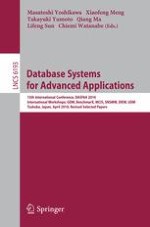2010 | Buch
Database Systems for Advanced Applications
15th International Conference, DASFAA 2010, International Workshops: GDM, BenchmarX, MCIS, SNSMW, DIEW, UDM, Tsukuba, Japan, April 1-4, 2010, Revised Selected Papers
herausgegeben von: Masatoshi Yoshikawa, Xiaofeng Meng, Takayuki Yumoto, Qiang Ma, Lifeng Sun, Chiemi Watanabe
Verlag: Springer Berlin Heidelberg
Buchreihe : Lecture Notes in Computer Science
